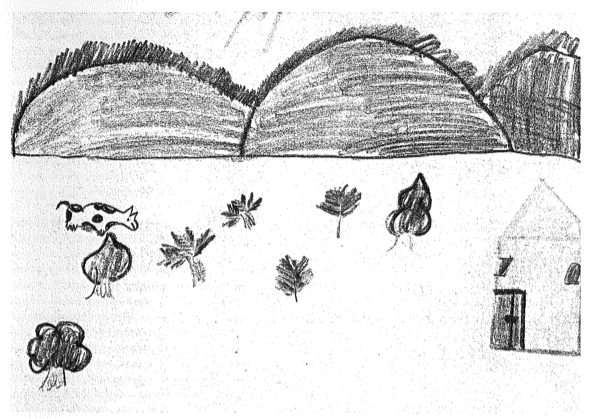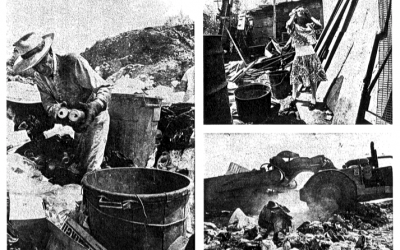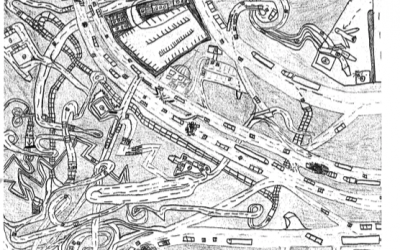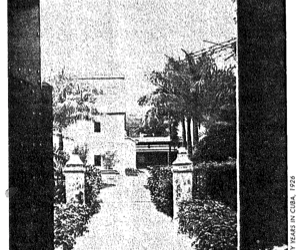The Environmental Agenda in Latin America
The Issue of the 21st Century

Katia Paola Gómez Campos from San Rafael School, Turrialba, Costa Rica drew this picture. “Costa Rica is a model for Latin America and the world.”
If the eighties was the decade of economic reforms, and the nineties that of political and social reforms, the 21st century will be that of environmental concerns. Environmental integrity, Economic Efficiency and Equity are the three EÃs that should guide policy in this area.
The quality of the environment depends on how we use land and natural resources. Every human activity, be it industry or farming, creates many kinds of polluting byproducts, which for centuries have been dumped on land, into the atmosphere, and into rivers, lakes, and into the ocean.
Latin America possess a very rich base of natural resources. With abundant minerals, from Mexico’s silver to Chile copper; it is plentiful in oil deposits (second largest reserves after the Middle East), has the largest forested surface of any continent, and the greatest proportion of arable land per person outside of North America, including some very good quality soils. Both the Pacific Coast and the South Atlantic are very rich in seafood.
Yet Latin America also has some of the most serious environmental problems in the world: air pollution in several Latin American cities is the worst anywhere; rivers flowing through industrial centers are tremendously contaminated by industrial wastes; the rate of deforestation is alarming; soil erosion is severely degrading some of the best agricultural land of the world.
Throughout Latin America, environmental problems reflect the clash between the use of nature as a private good with the concept of nature as a public good providing certain functions without which human life is not possible. Nature satisfies our requirement of food and fiber, helps recycle water and nutrients, is a source of beauty and comfort, and of the oxygen we need to breathe. Yet, since the adoption of agriculture ten thousand years go, a conflict has arisen in the use of nature. Farmers and other owners of real property view it as a private good including the right to modify it to suit their individual needs, which includes using it for farming, for livestock grazing, or for housing. All these activities can lead to profound landscape modifications leading to ecological deterioration, including loss of water retention capacity, nutrient cycling, and loss of biodiversity.
Nowhere is the clash between these two views more in evidence than in the debate over deforestation in the Amazon basin. While inhabitants of temperate industrialized countries (as well as sizable minorities in many tropical countries) rally to the slogan of ìsave the forests,î colonization of the Amazonian forest is encouraged by several South American countries and financed (at least in the past) by international agencies such as the World Bank.
Two issues dominate the debate: (1) securing food security and the kind of agriculture to adopt, and (2) reducing deforestation and landscape transformation. The first of these is of primary concern in Latin America; deforestation dominates the debate in the industrialized countries.
The use of the land as a ìprivate goodî is in conflict with the broader view held by the international community that see the tropical forest– and to a lesser extent other lands– as a ìpublic good.î The dilemma and the challenge is to find ways of meeting, if not completely at least partially, both needs.
Food security
With the proper land use practices, Latin American agriculture could become an important source of wealth in the next century; with inadequate practices, Latin America has the potential of destroying much of its fragile soils.
In the next fifty to a hundred years the world’s population– now 5.5 billion– will increase to about 10 billion. Much of that growth will be concentrated in the tropics and subtropics, including Mexico, Central America and much of South America. Food and fiber production will have to be doubled worldwide just to keep up with population growth. Although reports in the news emphasize mostly surpluses in the United States and Europe, in the last few years these surpluses have shrunk significantly with subsequently volatile grain prices. If food prices reverse their historical downward trend of the last hundred years, and prices were to increase, the world’s poor might not be able to obtain sufficient food, thus impairing poor nation’s development efforts. Consequently, a high priority for policy makers in food producing countries is to devise medium-to-long-term policies that will increase production to keep up with demand.
This is a formidable challenge, particularly if it is to be done without massive land degradation and soil erosion. Latin America has the largest reserves of potentially arable land ,but this is largely marginal land, with soil and humidity limitations, easily degraded if used incorrectly. When properly prepared, it can be very fertile as the soy bean fields of northern Mato Grosso in Brazil attest. However, high interest rates, low commodity prices, and an uncertain land tenure regime discourage farmers from investing in land conservation measures. Even in very good land, such as that of the northern area of the Argentine Pampas, overvaluation of the Argentine currency, low international prices, protection of markets by more inefficient producers especially the European Union, high interests rates, and inaccessibility of credit, have produced a serious decapitalization of Argentine agriculture with ensuing soil erosion and loss of productivity.
More agricultural and ecological research is needed to develop better agricultural techniques for marginal tropical lands. But the problem of the proper use of natural resources and agricultural land use include not only physical, biological, and ecological questions, but involves also issues of trade, national credit policies, the cost of capital, and international relations between nations. Consequently the development of solutions demands a truly interdisciplinary effort.
The last decade has seen economic reforms, some of which have had a positive effect on agricultural development, such as Argentina’s dropping of export taxes. Other measures, such as the reduction in research expenditures in the sector, have in general had a negative effect. Economic policy makers often feel that transfer of foreign technology is cheaper than maintaining a national research establishment. This view is bolstered by the successful privatization of other government enterprises. Although some technology can be and should be transferred, given that the physical and climatic conditions that affect agricultural yields vary from site to site, some local research capacity is always necessary.
Some observers, particularly ecologists and some agricultural scientists, doubt the feasibility of increasing food production without drastic changes in the methods of production. Although agricultural indistrialization has been successful in increasing yields, they say, it has created serious environmental problems, including excessive topsoil erosion, water pollution, depletion of aquifers, loss of wetlands, and of natural habitats. Land concentration, displacement of farm families, and the consolidation of food and fiber production are also of great concern to these critics. The consolidation of large corporations and the disappearance of the family farm affect small rural communities, that are also disappearing, they worry. According to these critics, corporations may be under pressure to maximize short term profits and therefore may not have an interest in preserving the natural resource base of agriculture. This eventually could lead to reduction of productivity and an increase in prices, and malnutrition for those unable to afford the higher prices.
Modern high input agriculture, as developed in the United States, is very capital intensive but uses very little labor. Such an approach does not make sense in countries with high unemployment rates and very short in investment capital. The challenge is to develop a high yield agriculture that is labor intensive but uses less capital.
Deforestation
Tropical forest are the greatest reservoir of prokaryote, fungal, plant, and animal species diversity in the world and hold the largest stocks of sequestered carbon, whose release into the atmosphere in the form of CO2 could significantly affect world climate. As such they probably constitute the worldÃs largest ìpublic good.î By that I mean, that preserving the biodiversity of tropical forests and reducing greenhouse gas emissions is of general concern to society at large.
Tropical forests occupy a large portion of the surface in eleven Latin American countries with significant population pressures and low to medium incomes: Mexico, Guatemala, Costa Rica, Panama, Honduras, Colombia, Venezuela, Ecuador, Per?, Bolivia, and Paraguay.. The use of these forest lands as timber resources, for growing tropical products, or for crop agriculture or cattle grazing, can help alleviate poverty and fulfill the local countryÃs need for more foreign exchange and food.
The intricate dilemma of the “public” versus the “private” good is further complicated by the variety of sovereign political jurisdictions-state, provincial, local-that are involved, each of them with wide responsibilities for the welfare of their citizens and differing views of the role that tropical forest are supposed to play.
The conservation of forest resources appears very simple: close the forest to economic activities that endanger its integrity, such as logging and farming. Yet such a simple and naÃve solution is clearly politically and economically impossible. Many tropical governments with extensive forest resources such as Brazil actually encourage migration of the landless poor to the forest margins to relieve demographic pressures.
There is no easy solution to this problem. The only viable option is to encourage increased agricultural productivity through modernization of the agrarian sector in areas already deforested. The development of rural industries to increase agrarian production can both satisfy the local and national needs for food and fiber and produce necessary savings for development and non-rural employment, thus reducing pressure on the forest. These were the successful strategies pursued by Europe and the United States in the last century and later by countries such as Argentina and Australia, and more recently Chile and Thailand among others. But this is a slow and laborious process at best. It is made even more difficult when countries are faced with high demographic growth and unemployment and high expectations for economic improvement.
Other policy issues
Because industrial activities, especially those of large corporations, are often the source of pollutants, the tendency world-wide has been to develop prescriptive rules to force polluters to internalize environmental costs, under the generally accepted rule that who pollutes should pay rather than have downstream users pay. In many instances these rules are necessary and welcomed by industry because they equalize the costs and reward responsible behavior. However, sources of environmental degradation, particularly in agriculture, cannot always be controlled. The activities of millions of individuals in all walks of life are responsible for much environmental degradation: farmers using dangerous pesticides, and employing inadequate land use practices; peasants and cattlemen cutting down forests to grow their crops and raisecattle; people using wood and petroleum derivatives to heat their houses and cook their food; and above all the use of gasoline in automobiles. The attempt to prescribe behavioral rules to individual citizens, rules that conflict with their own self-interest is ineffective and is likely to produce a backlash, as we are experiencing in the United States. Instead we need to develop environmentally friendly techniques that are also economically attractive so that it eventually be in our self-interest not to degrade rather than degrade.
For citizens to adopt environmentally friendly behavior, reliable and fair legal mechanisms must be created to enforce long-term property rights and other legal obligations. Unfortunately too often the judicial system in Latin America responds to political pressures when it is not downright corrupt. Legal reforms are also needed to ensure the adoption of environmentally friendly policies by both governments and individuals. Many countries possess adequate environmental legislation; almost all Latin American countries have a cabinet level environmental official. Yet these ministries are usually without enforcement power. An exception, and a model for Latin America and the world, is Costa Rica.
The capacity of the environment to provide those ecological services on which human life depends must be maintained: nutrient and water cycling, oxygen production, and the many aspects of the geochemical cycle. To accomplish this the efficiency with which we use resources must be increased: less waste, more conservation of resources, both short and long term, and more recycling of materials. And finally social equity to eliminate poverty, increased education, including appreciation for nature and its role, is essential to spread the benefits to all, and to make everybody responsible for the maintenance of the health of this planet, our only home in the Universe.
Fall 1998
Otto T. Solbrig is Bussey Professor of Biology and a fellow of the Weatherhead Center for International Affairs. Solbrig, a member of the DRCLAS Executive Committee, recently won the 1998 International Prize for Biology, presented by the Japan Society for the Promotion of Science.
Related Articles
The Urban Environment
Urbanization has transformed Latin America over the last forty years. Its cities, always diverse and lively, have now also become chaotic and centers of social conflict. Millions of subsistence…
The Environment
In planning my schedule for the weeks of research I spent on the U.S.-Mexican border this summer, I knew I would have to factor traffic into my plans. This was certainly on my mind as…
The Cienfuegos Botanical Garden
The Cienfuegos Botanical Garden, about three-quarters of an hour outside the Cuban city of Cienfuegos at the “Pepito Tey” sugar complex, welcomes visitors to a park-like setting of palms…





